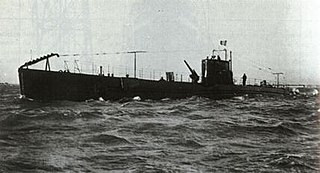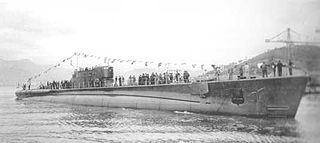Design and description
The R-class submarines displaced 2,155 metric tons (2,121 long tons) surfaced and 2,560 metric tons (2,520 long tons) submerged. The submarines were 86.5 meters (283 ft 10 in) long, had a beam of 7.86 meters (25 ft 9 in) and a draft of 5.34 meters (17 ft 6 in). They had a cargo capacity of 600 tonnes (591 long tons). [1]
For surface running, the boats were powered by two 1,300- brake-horsepower (969 kW) diesel engines, each driving one propeller shaft. When submerged each propeller was driven by a 450-horsepower (336 kW) electric motor. They could reach 13 knots (24 km/h; 15 mph) on the surface and 6 knots (11 km/h; 6.9 mph) underwater. On the surface, the R class had a range of 12,000 nautical miles (22,000 km; 14,000 mi) at 9 knots (17 km/h; 10 mph); submerged, they had a range of 110 nmi (200 km; 130 mi) at 3.5 knots (6.5 km/h; 4.0 mph). [2]
The boats were only armed for self-defense with three 20-millimeter (0.79 in) light anti-aircraft guns. Some boats may have been equipped with a pair of internal 45 cm (17.7 in) torpedo tubes in the bow and stern. [1]

The Type A1 submarine, also called I-9-class submarine were a trio of aircraft-carrying cruiser submarines built for the Imperial Japanese Navy (IJN) during the 1930s. All three participated in the Pacific War and were lost.
The Glauco class was a pair of submarines ordered by the Portuguese government, but were taken over and completed for the Regia Marina during the 1930s. They played a minor role in the Spanish Civil War of 1936–1939 supporting the Spanish Nationalists.

The Brin-class submarine was a group of five long-range submarines built for the Royal Italian Navy during the 1930s.
Comandante Faà di Bruno, also referred to by its shortened name Faà di Bruno, was a Marcello-class submarine built for the Royal Italian Navy in the 1930s. It was sunk in 1940 by British and Canadian destroyers escorting a convoy.
The Italian submarine Acciaio was the name ship of her class of submarines built for the Royal Italian Navy during World War II.
The Italian submarine Flutto was the name ship of her class of submarines built for the Royal Italian Navy during World War II. She obtained no successes during her short career, and was sunk by British ships during the Invasion of Sicily in 1943.

Delfino was one of four Squalo-class submarines built for the Regia Marina during the late 1920s. The boat served in World War II and was sunk in 1943 after a collision with another Italian ship.

The Squalo-class submarines were a group of four submarines built for the Royal Italian Navy during the 1930s. They were built at the Cantieri Riuniti dell'Adriatico (CRDA) shipyard at Monfalcone, and designed by Curio Bernardis.

The Argonauta-class submarine was the first sub-class of the 600 Series of coastal submarines built for the Regia Marina during the 1930s. Some of these boats played a minor role in the Spanish Civil War of 1936–1939 supporting the Spanish Nationalists. Of the seven boats built in this class, only a single one survived the Second World War.

Enrico Tazzoli was one of three Calvi-class submarines built for the Regia Marina during the 1930s. Completed in 1936, she played a minor role in the Spanish Civil War of 1936–1939 supporting the Spanish Nationalists. She operated in the Atlantic during the Second World War and was second only to the submarine Leonardo da Vinci as the highest scoring Italian submarine of the conflict. Enrico Tazzoli was converted in 1943 to be a submarine transport for blockade-running between Europe and the Far East. She was lost on her first voyage in this role.
Argo was the lead ship of her class of two submarines ordered by the Portuguese government, but taken over and completed for the Regia Marina during the 1930s.
Nereide was one of a dozen Sirena-class submarines, the second sub-class of the 600 Series of coastal submarines built for the Regia Marina during the early 1930s.
Ondina was one of a dozen Sirena-class submarines, the second sub-class of the 600 Series of coastal submarines built for the Regia Marina during the early 1930s.
Rubino was one of a dozen Sirena-class submarines, the second sub-class of the 600 Series of coastal submarines built for the Regia Marina during the early 1930s.
Argonauta was the lead ship of her class of seven submarines built for the Regia Marina during the early 1930s.
Jantina was one of seven Argonauta-class submarines built for the Regia Marina during the early 1930s. She played a minor role in the Spanish Civil War of 1936–1939 supporting the Spanish Nationalists, and was later sunk during World War II.
Serpente was one of seven Argonauta-class submarines built for the Regia Marina during the early 1930s.

Narvalo was one of four Squalo-class submarines built for the Regia Marina during the late 1920s. The boat served in World War II and was sunk in 1943 by British destroyers and aircraft.

Tricheco was one of four Squalo-class submarines built for the Regia Marina during the late 1920s. The boat served in World War II and was sunk in 1942 by the British submarine HMS Upholder.
The Bragadin-class submarines were built for the Regia Marina during the late 1920s. Both boats participated in the Second World War and were discarded in 1948.
This page is based on this
Wikipedia article Text is available under the
CC BY-SA 4.0 license; additional terms may apply.
Images, videos and audio are available under their respective licenses.





